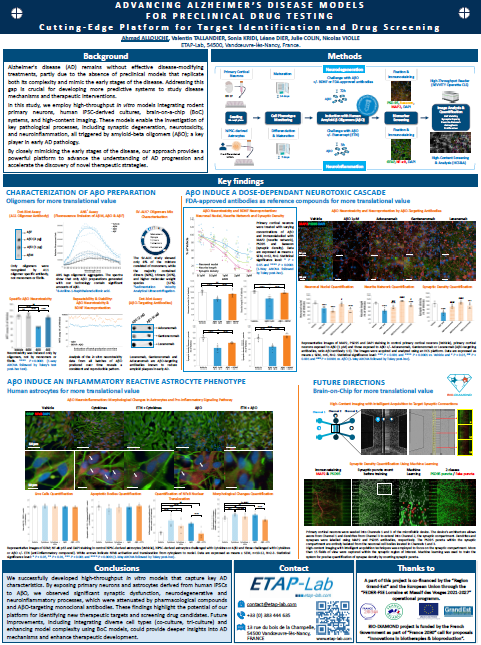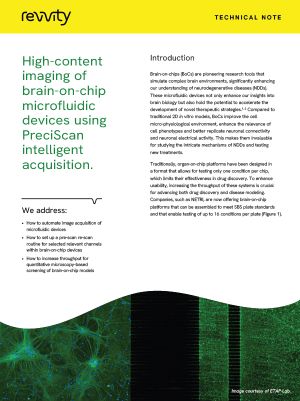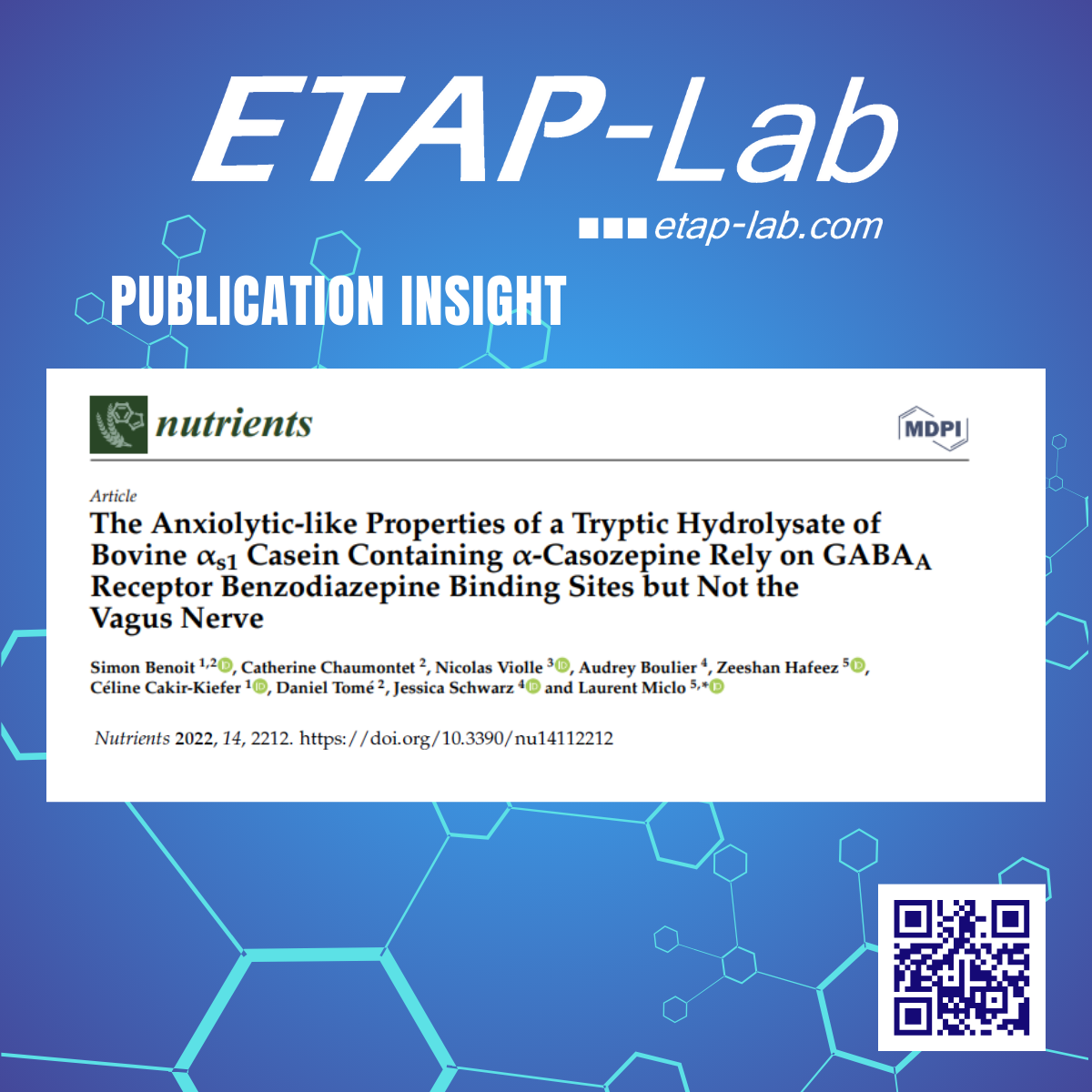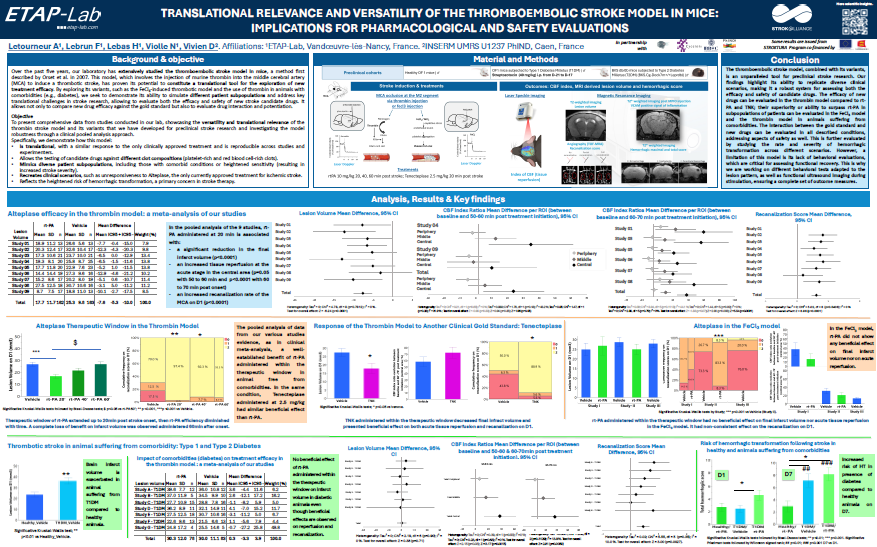POSTER: “ADVANCING ALZHEIMER’S DISEASE MODELS FOR PRECLINICAL DRUG TESTING”
Dr Ahmad Allouche, Head of in vitro biology, presented the team's research* during AD/PD 2025 in Vienna in his poster "ADVANCING ALZHEIMER'S DISEASE MODELS FOR PRECLINICAL DRUG TESTING". Learn more about our cutting-edge platform for target identification & drug discovery in the poster! Until the poster is available here, don't wait any longer and ask for the poster in PDF! *Ahmad ALLOUCHE, Valentin TALLANDIER, Sonia KRIDI, Léane DIER, Julie COLIN, Nicolas VIOLLE
Technical Note: High-content imaging of brain-on-chip microfluidic devices using PreciScan intelligent acquisition.
Brain-on-chips (BoC) are innovative tools that simulate complex brain environments, enhancing our understanding of neurodegenerative diseases (NDDs). While a range of BoC platforms have been developed to model diverse NDD pathophysiologies, the various channel architectures of these microfluidic devices present challenges in image acquisition and analysis. High-content imaging protocols must be adaptable to these differing designs. This Technical Note, developed by Revvity in collaboration with ETAP-Lab, demonstrates an automated image acquisition protocol for BoC microfluidic devices. The protocol utilizes the Operetta
Exciting research publication from our cardiology lab SYNCROSOME as co-author
Cardiovascular diseases (CVDs) are the leading cause of global mortality. That's why we are proud to share a groundbreaking study titled "Urolithin A provides cardioprotection and mitochondrial quality enhancement preclinically and improves human cardiovascular health biomarkers". Liu, Sophia et al. iScience, Volume 28, Issue 2, 111814 This study highlights the potential of Urolithin A (UA), a post-biotic and mitophagy activator, to improve heart health by addressing mitochondrial dysfunctions. Preclinical model results show reduced cardiac dysfunction, while human trials indicate significant reductions
A signifiant milestone for our publication on Nutrients journal
We wanted to highlight on our recent article on our psychopharmacology research "The Anxiolytic-like Properties of a Tryptic Hydrolysate of Bovine αs1 Casein Containing α-Casozepine Rely on GABAA Receptor Benzodiazepine Binding Sites but Not the Vagus Nerve" that has reached over 3000 views in MDPI Nutrients journal! The published data on the anxiolytic-like properties of bovine αs1-casein (CH) support that: α-casozepine is responsive for the anxiolytic-like effects of the alpha-s1-casein tryptic hydrolysate (CH). CH anxiolytic-like effects are not mediated by the
POSTER: “Translational Relevance and Versatility of the Thromboembolic Stroke Model in Mice: Implications for Pharmacological and Safety Evaluations”
Dr Annelise LETOURNEUR, Director of Operations at STROK@LLIANCE and Neuroscience Study Director, presented the team's research* during the American Heart Association’s annual International Stroke Conference 2025, in Los Angeles, in her poster "Translational Relevance and Versatility of the Thromboembolic Stroke Model in Mice: Implications for Pharmacological and Safety Evaluations". Learn more about our original preclinical results for in vivo trials on stroke disease, see the poster! Until the poster is available here, don't wait any longer and ask for the poster in
Improving Stroke Outcomes in Hyperglycemic Mice by Modulating tPA/NMDAR Signaling to Reduce Inflammation and Hemorrhages
The pharmacological intervention for ischemic stroke hinges on intravenous administration of the recombinant tissue-type plasminogen activator (rtPA, Alteplase/Actilyse®) either as a standalone treatment or in conjunction with thrombectomy. However, despite its clinical significance, broader employment of rtPA is constrained due to the risk of hemorrhagic transformations (HTs). Furthermore, the presence of diabetes or chronic hyperglycemia is associated with an elevated risk of HT subsequent to thrombolysis. This detrimental impact of tPA on the neurovascular unit in hyperglycemic patients has been
Dynamics of cerebral blood volume during and after middle cerebral artery occlusion in rats – Comparison between ultrafast ultrasound and dynamic susceptibility contrast-enhanced MRI measurements
Tomographic perfusion imaging techniques are integral to translational stroke research paradigms that advance our understanding of the disease. Functional ultrasound (fUS) is an emerging technique that informs on cerebral blood volume (CBV) through ultrasensitive Doppler and flow velocity (CBFv) through ultrafast localization microscopy. It is not known how experimental results compare with a classical CBV-probing technique such as dynamic susceptibility contrast-enhanced perfusion MRI (DSC-MRI). To that end, we assessed hemodynamics based on uUS (n = 6) or DSC-MRI (n =
A New Moisturiser Improves DNCB-induced Atopic Dermatitis-like Symptoms and Restores Skin Barrier Function in BALB/c Mice
Evaluation of a New Moisturiser for Atopic Dermatitis in a Murine Model Introduction Atopic dermatitis (AD) is a chronic, inflammatory skin disorder with eczematous and pruritic lesions. Topical moisturisers and either topical corticosteroids or calcineurin inhibitors are usually recommended. Restoring the skin barrier function alleviates AD symptoms. Objective To evaluate the efficacy of a new moisturiser compared to commercially available products in an AD murine model. Methods Experimental AD was induced with topical applications of 2,4-DiNitroChloroBenzene (DNCB) on the shaved back skin of BALB/c mice from
The Anxiolytic-like Properties of a Tryptic Hydrolysate of Bovine αs1 Casein Containing α-Casozepine Rely on GABAA Receptor Benzodiazepine Binding Sites but Not the Vagus Nerve
The Anxiolytic-like Properties of a Tryptic Hydrolysate of Bovine αs1 Casein Containing α-Casozepine Rely on GABAA Receptor Benzodiazepine Binding Sites but Not the Vagus Nerve(CH) Background A tryptic hydrolysate of bovine αs1-casein (CH) exerts anxiolytic-like properties in many species, including humans. This is mainly related to the presence of α-casozepine (α-CZP), which yields these properties in rodents. This study evaluates, in a rat model, the roles of the vagus nerve and the benzodiazepine binding site of GABAA receptors in the mode of
Antitumor Effect and Induced Immune Response Following Exposure of Hexaminolevulinate and Blue Light in Combination with Checkpoint Inhibitor in an Orthotopic Model of Rat Bladder Cancer
Previous studies have found that use of hexaminolevulinate (HAL) and blue light cystoscopy (BLC) during treatment of bladder cancer had a positive impact on overall survival after later cystectomy, indicating a potential treatment effect beyond improved diagnostic accuracy. The aim of our study was to determine whether HAL and BL mimicking clinically relevant doses in an orthotopic rat model could have therapeutic effect by inducing modulation of a tumor-specific immune response. We also assessed whether administration with a checkpoint inhibitor







